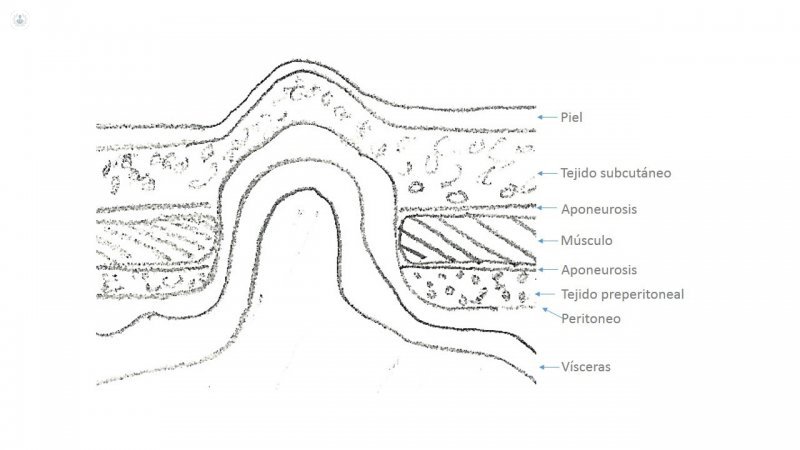Hernia:causes, symptoms and treatment
Written in association with:The abdominal eventration is a protrusion or displacement of viscera (abdominal) through a defect of the abdominal wall.

The layers of the abdominal wall are, from the exterior to the interior, the following:
- The skin.
- Subcutaneous cellular tissue or subcutaneous fat .
- Aponeurosis (a variety of tendon).
- Muscle layer (layer 1).
- Aponeurosis (layer 2).
- Preperitoneal fatty tissue and peritoneum (a membrane that covers most of the organs of the abdomen).
In certain areas, layers 1 and 2 may vary in number or be absent, with only one of the two aponeurotic layers , which occurs just in the midline of the anterior wall of the abdomen or linea alba.
The defect of the muscular-aponeurotic layers produces the output of a hernial sac formed by peritoneum through the hernial orifice (the muscle-aponeurotic defect), which produces a visible hernia from the outside.
Causes of eventration
The eventration, also called ventral hernia or incisional hernia , occurs after a history of penetrating trauma to the abdominal wall or surgery. The incidence of occurrences varies between 1 and 16%, although this percentage may be higher depending on the type of surgery.
The occurrence of these events is also related to the presence of risk factors, such as obesity or overweight , contaminated surgery , diabetes , immunosuppression or other underlying diseases, the surgical technique (factors dependent on the surgeon), and The appearance of infection in the initial surgical wound on which the eventration will appear.
Symptoms of eventration
The symptoms that produce the patient are the presence of a tumor or deformity of the abdominal wall at or near the scar level, which is usually accompanied by pain or discomfort to a greater or lesser degree. Sometimes, depending on the morphotype characteristics of the patient and the hernia itself, pain may be the only symptom.
In some cases, the presence of intestine within the hernial sac with adhesions to it may be a cause of intestinal transit disorders that manifest as more or less manifest intestinal occlusion episodes.
However, all eventrations are subject to the possibility of suffering episodes of incarceration, that is, the entrainment of the viscera in a narrow hole, such as a hernia; And even strangulation. These pictures usually cause intense and maintained pain and inflammation in the area of the eventration, and can lead to disseminated abdominal pain and even fever.
The strangulation of the hernia supposes the appearance of a vascular compromise of the hernia content with the consequent ischemia of the content. If the contents are an intestinal loop or colon and ischemia is maintained over time, a perforation of the bowel may occur.
Treatment of eventration
When one of these complications occurs an intervention must be performed through the general surgery of an urgent way of the hernia. Even so, surgery is always elective; That is, the patient's own choice. The surgical approach can be by open or laparoscopic surgery and always involves anatomical correction of the defect as far as possible and reinforcement by the placement of the mesh.
There are many types and marks of meshes or wall prostheses on the market today and the surgeon will choose them depending on the type of hernia, the conditions of the repair (presence of infection, position of the mesh with respect to the planes of the Abdominal wall), the approach (open or laparoscopic) and its surgical experience.


